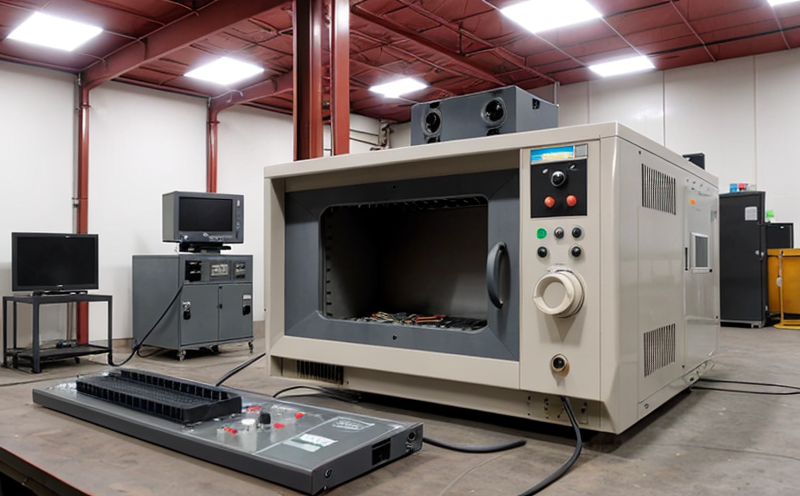BS EN 50155 Railway Electronics Testing in UK
The British Standard EN 50155 is a critical document that sets the requirements for embedded electronics used in railway applications. It ensures that electronic products meet essential safety, performance, and reliability criteria required by European railways. This standard applies to all types of trains, including high-speed trains, metros, trams, and light rail vehicles.
The primary purpose of this testing is to verify that the electronic components within these systems can withstand the harsh conditions found in railway environments. These conditions include vibration, temperature fluctuations, humidity, and power supply variations. The standard aims to prevent failures that could lead to operational disruptions or safety hazards.
Testing under EN 50155 involves a series of rigorous procedures designed to simulate real-world conditions experienced by electronics installed on rolling stock. This includes shock testing, vibration testing, temperature cycling, and humidity tests. Compliance with these tests is essential for manufacturers aiming to meet the stringent requirements set forth in this standard.
For quality managers and compliance officers within the railway sector, ensuring that products are compliant with BS EN 50155 is crucial. It ensures not only regulatory adherence but also enhances product reliability, reducing the risk of failures during critical operations. This testing process helps in identifying potential issues early on, thereby saving costs associated with field repairs or recalls.
R&D engineers working on innovative railway projects benefit greatly from this service as it allows them to refine their prototypes before full-scale production. By adhering to these standards, manufacturers can gain confidence that their products will perform reliably under all conditions specified by the standard. This is particularly important for companies involved in procurement processes where supplier compliance with international standards is a key consideration.
The scope of testing covers various aspects relevant to embedded electronics within railway applications:
| Test Category | Description | Objective |
|---|---|---|
| Shock Testing | Evaluates the ability of electronic products to survive mechanical shocks during transportation and installation. | Ensures durability against external impacts. |
| Vibration Testing | Simulates the effects of vibrations encountered in railway environments. | Verifies stability under dynamic conditions. |
| Temperature Cycling | Exposes products to alternating high and low temperatures. | Evaluates thermal resilience and performance variability. |
| Humidity Testing | Determines resistance to moisture ingress and corrosion. | Avoids degradation due to environmental factors. |
| Power Supply Variations | Assesses tolerance to fluctuations in supply voltage. | Maintains functionality despite power instability. |
The testing process typically involves a combination of laboratory simulations and field trials. Lab-based tests provide controlled environments allowing for precise measurement and analysis, while field trials offer real-world data under actual operating conditions. Both approaches contribute valuable insights into the performance characteristics of electronic components in railway systems.
Manufacturers should prepare their specimens according to specified guidelines provided within the standard document. This includes selecting appropriate types of components based on intended use, ensuring proper installation methods, and following recommended procedures for handling and shipping test samples.
The results from these tests are documented comprehensively through detailed reports that outline findings, observations, and recommendations. These reports serve as essential references for future design iterations or modifications required to enhance compliance levels further.
Applied Standards
The British Standard EN 50155 is one of several international standards that address the specific challenges faced by embedded electronics in railway applications. It aligns closely with other relevant documents such as IEC 61373, which deals specifically with vibration testing for transport equipment; ISO/TS 22712, focusing on temperature cycling tests; and EN 50154, dealing with power supply requirements.
Compliance with these standards not only ensures that products meet regulatory expectations but also fosters confidence among stakeholders regarding product quality. By adhering to internationally recognized guidelines like those specified in BS EN 50155, manufacturers can ensure their offerings are well-suited for use across diverse railway networks worldwide.
Scope and Methodology
The scope of testing under BS EN 50155 encompasses a wide range of parameters aimed at ensuring the robustness and reliability of embedded electronics in railway applications. This includes evaluating the performance of electronic components subjected to various environmental stresses such as shock, vibration, temperature cycling, humidity exposure, and power supply variations.
The methodology involves several key steps:
- Identification of relevant test parameters based on specific application requirements.
- Preparation of specimens according to prescribed specifications.
- Conducting laboratory tests using specialized equipment designed for simulating real-world conditions.
- Performing field trials where necessary to gather additional data under actual operating conditions.
- Documenting results meticulously in comprehensive reports that include recommendations for improvement if needed.
This holistic approach ensures thorough evaluation of electronic products, providing manufacturers with valuable information about potential weaknesses or areas requiring enhancement. The detailed documentation serves as a critical resource for ongoing quality assurance efforts and continuous improvement initiatives.
Why Choose This Test
- Regulatory Compliance: Ensures adherence to international standards, facilitating smoother market entry into European railways.
- Enhanced Reliability: Identifies and addresses potential vulnerabilities early in the development cycle, improving overall product reliability.
- Risk Management: Minimizes risks associated with equipment failures by ensuring robust design practices are followed rigorously.
- Cost Efficiency: Prevents costly recalls or field repairs by identifying issues during controlled testing phases.
- Innovation Support: Allows R&D teams to refine prototypes based on rigorous testing data, leading to more advanced product offerings.
- Confidence Building: Provides assurance that products meet stringent safety and performance criteria, enhancing stakeholder trust.
By choosing this test, organizations can demonstrate their commitment to quality and reliability, ultimately contributing to safer and more efficient railway operations.





